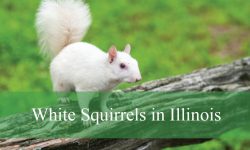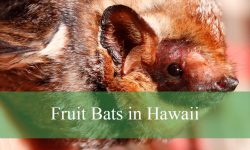Ohio might not be the first state that comes to mind when you think of lizards, yet these fascinating reptiles quietly inhabit the state’s forests, fields, and even city walls. From the swift and secretive skinks that dart under logs to the rugged fence lizards basking on sunlit rocks, Ohio’s lizard species reveal a side of the state’s wildlife that many people overlook.
Each lizard plays a vital ecological role—controlling insect populations, enriching soil ecosystems, and adding diversity to Ohio’s natural landscapes. Their adaptability allows them to thrive across various environments, from damp woodland floors to dry urban masonry. Observing these agile creatures offers insight into how reptiles survive in temperate climates with cold winters and hot summers.
This guide introduces six types of lizards found in Ohio, with clear identification details, physical characteristics, habitat information, and behavioral insights. Exploring these reptiles reveals just how rich and fascinating Ohio’s natural heritage can be, even in places where few expect to find them.
Common Types of Lizards Found in Ohio
Common Five-Lined Skink (Plestiodon fasciatus)
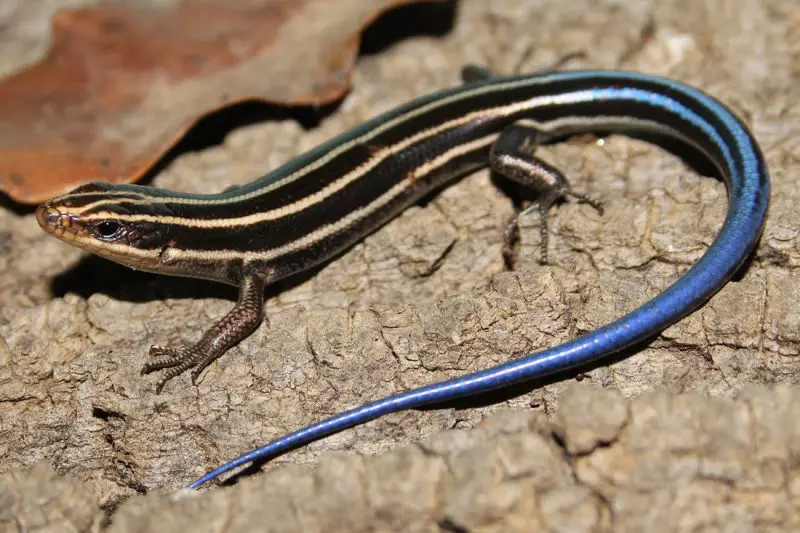
The Common Five-Lined Skink is one of Ohio’s most widespread and recognizable lizards, often found in woodlands, rocky hillsides, and decaying logs. This species is named for the five distinct light stripes that run along its dark brown or black body, creating a sharp contrast that makes it easy to identify. Juveniles are especially striking, with bright blue tails that fade as they age, while adults tend to lose some of the contrast in their stripes and take on a more uniform brownish tone.
Adult Common Five-Lined Skinks typically measure between 5 and 8.5 inches in total length, including the tail. Their smooth, shiny scales give them a sleek appearance, aiding in moisture retention and quick movement through their environment. Males can be distinguished from females during the breeding season by their reddish-orange heads, which intensify in color during courtship. Females, on the other hand, retain more defined striping patterns and have smaller, less vivid heads.
Behaviorally, this skink is secretive and agile, often darting quickly under logs, leaf litter, or stones when disturbed. It is diurnal, preferring warm daylight hours for hunting and basking. Its diet mainly consists of insects, spiders, and other small invertebrates, making it an important predator in maintaining ecological balance. During the cooler months, it enters a state of brumation, sheltering in underground burrows or under tree roots.
Common Five-Lined Skinks prefer habitats that provide both warmth and cover. They thrive in mixed hardwood forests, edges of clearings, and even abandoned structures where sunlight reaches the ground. Decaying wood and fallen branches serve as perfect microhabitats, offering protection from predators and ideal nesting sites for females. Their adaptability allows them to persist even in moderately disturbed environments.
In Ohio, this skink is found throughout the southern and eastern regions, with scattered populations reaching into central parts of the state. They are most abundant in areas with ample woodland cover and minimal urban disturbance. Because of their broad range and adaptability, the Common Five-Lined Skink remains a stable and thriving component of Ohio’s reptile fauna.
Broad-Headed Skink (Plestiodon laticeps)

The Broad-Headed Skink is Ohio’s largest native lizard, instantly recognizable by its robust build and prominent head. Adult males, in particular, have an enlarged, broad head and vivid orange-red coloration during the breeding season, which gives the species its name. Females and juveniles, however, resemble the Common Five-Lined Skink, with five distinct stripes running along their bodies.
Broad-Headed Skinks can reach lengths of up to 13 inches, though most individuals range between 7 and 9 inches. Their smooth, shiny scales vary from olive-brown to grayish-brown, with younger lizards displaying the classic blue tail. As they age, the stripes often fade, especially in males. Their muscular build and large jaws make them powerful hunters compared to other skink species in the region.
These lizards are primarily arboreal, spending a great deal of time climbing trees, logs, and wooden fences. They are strong climbers, often found high in trees where they bask or hunt for insects and spiders. Broad-Headed Skinks are solitary and territorial, with males defending their area aggressively during mating season. Their diet is composed of crickets, beetles, grasshoppers, and other soft-bodied insects.
Preferred habitats for Broad-Headed Skinks include mature forests with an abundance of fallen logs, tree cavities, and sunny clearings. They rely on rotting stumps and bark crevices for nesting and refuge. Females lay clutches of 6 to 15 eggs in protected areas, often guarding them until hatching—an unusual display of parental care among reptiles. They require warm, humid conditions to thrive, making them more common in the southern part of the state.
In Ohio, Broad-Headed Skinks are primarily confined to the southernmost counties, particularly along the Ohio River Valley. Their range overlaps slightly with the Common Five-Lined Skink, but they prefer warmer, more forested environments. While not considered threatened, habitat loss and urban development can impact local populations, especially in areas where large trees are removed.
Little Brown Skink (Scincella lateralis)
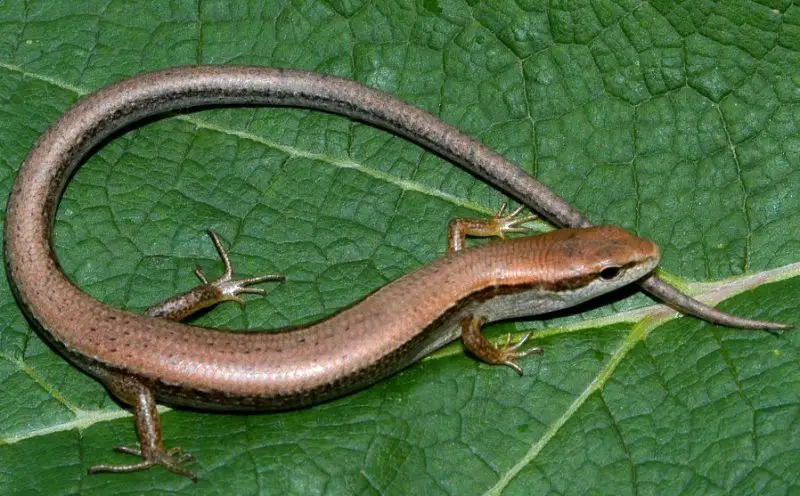
The Little Brown Skink, also known as the Ground Skink, is the smallest lizard species found in Ohio. It has a slender body, smooth bronze or copper-colored scales, and a dark line running from the snout through the eye down to the tail. Its small size and coloration make it perfectly camouflaged among leaf litter, allowing it to remain nearly invisible to predators and human observers alike.
Typically, the Little Brown Skink grows to about 3 to 5 inches in length, making it significantly smaller than other Ohio skinks. Its shiny, scale-covered body reflects sunlight subtly, helping to regulate temperature and reduce water loss. Unlike other skinks, it has small, delicate limbs and a narrow head, giving it a serpentine appearance when it moves quickly through debris on the forest floor.
Behaviorally, the Little Brown Skink is secretive and spends most of its life hidden beneath leaves, soil, or logs. It is one of the few lizards that prefers to remain at or below ground level rather than climbing. Its movements are fast and smooth, making it difficult to capture or even observe. It feeds primarily on small insects, springtails, and spiders, using quick flicks of its tongue to locate prey.
The preferred habitat for this species includes moist woodlands, ravines, and shaded hillsides with abundant leaf litter. They thrive in microhabitats that remain cool and damp throughout the day, relying on ground cover for both protection and temperature control. During colder months, they burrow into soil or decaying vegetation to overwinter safely.
In Ohio, the Little Brown Skink is primarily found in the southern and southeastern counties. Its distribution is limited compared to other skinks, largely due to its need for moist, undisturbed forest floors. Populations are stable where suitable habitat remains, though deforestation and development can fragment their range and reduce their numbers in certain regions.
Common Wall Lizard (Podarcis muralis)
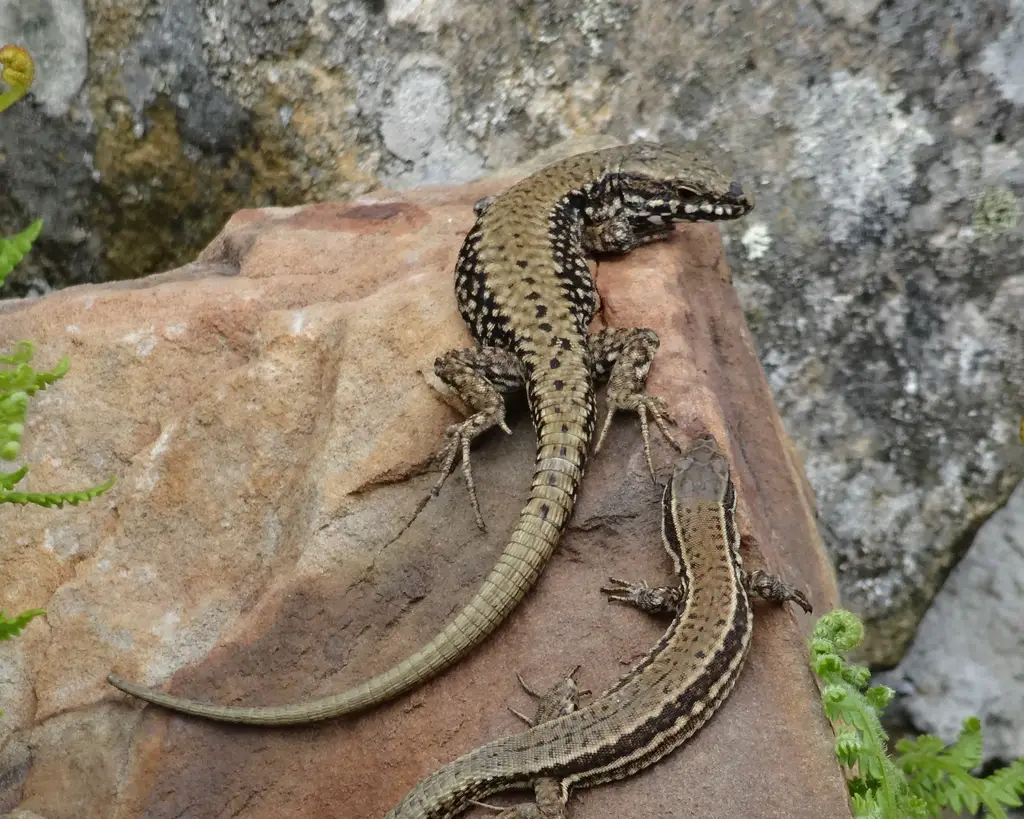
The Common Wall Lizard is Ohio’s most well-known introduced lizard species. Native to southern Europe, it was accidentally released in the Cincinnati area in the 1950s and has since established a thriving population. These lizards are small, agile, and quick, often seen basking on walls, rocks, and pavement in urban or suburban settings.
Adults typically reach lengths of 6 to 8 inches, including the tail. Their coloration varies from brown to greenish-gray with darker spots or patterns along the back. Males often display brighter green hues, particularly during the breeding season. The body is slender with long legs and a pointed snout, giving them a distinctive look compared to Ohio’s native skinks. Their tails can break off as a defense mechanism and later regenerate.
Common Wall Lizards are diurnal and highly active, often basking in the sun during warm mornings and retreating to crevices when temperatures rise. They feed on insects, spiders, and small invertebrates, playing a similar ecological role to native species. Their behavior is bold and adaptable—they can thrive in areas heavily modified by humans, including city parks, gardens, and stone walls.
This species prefers dry, sunny habitats with plenty of rock surfaces or masonry for basking. They are not dependent on forest cover and are frequently found near human-made structures such as retaining walls, staircases, and railroad tracks. Females lay multiple clutches of small eggs each year, allowing populations to grow rapidly in favorable conditions.
In Ohio, the Common Wall Lizard is mainly found in and around Cincinnati, where it has adapted remarkably well to the local environment. It has spread along the Ohio River corridor and into nearby suburbs. Despite being non-native, it coexists peacefully with local wildlife and is not currently considered invasive or ecologically harmful.
Six-Lined Racerunner (Aspidoscelis sexlineata)
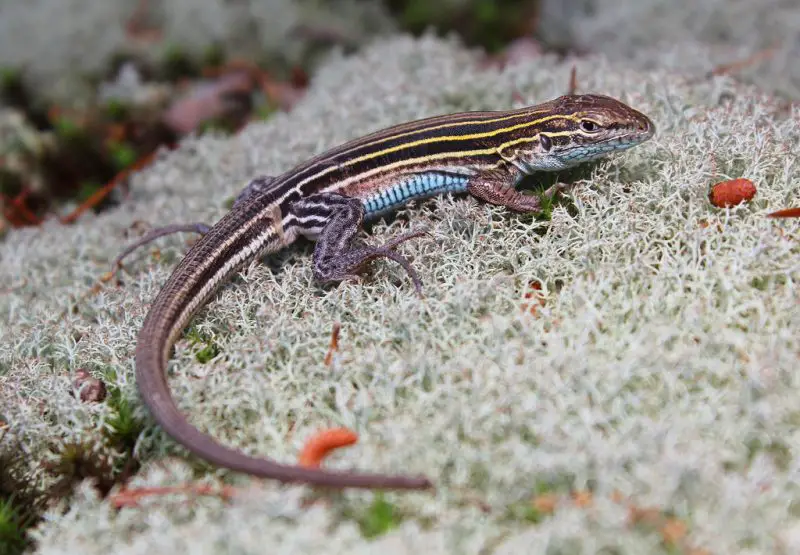
The Six-Lined Racerunner is one of the fastest reptiles in Ohio and easily recognized by its sleek body and six bright yellow stripes running from head to tail. Its back is typically dark green or black, creating a high-contrast pattern that distinguishes it from other species. This energetic lizard is built for speed and agility, perfectly adapted to open, sunlit environments.
Adult Racerunners measure between 6 and 10 inches long, with long tails that often exceed their body length. Their scales are small and granular, providing flexibility and minimizing friction as they sprint across sandy or rocky terrain. Males often have bluish undersides, while females are paler and less vividly marked. Their sharp claws and strong legs enable them to move quickly even through tall grass or loose soil.
Behaviorally, the Six-Lined Racerunner is diurnal and highly active, rarely staying still for long. It spends much of the day hunting insects, grasshoppers, beetles, and spiders, relying on keen eyesight and quick reflexes to capture prey. When startled, it dashes into burrows or under vegetation, often running in short bursts at incredible speeds. These lizards are wary of humans and difficult to observe closely.
Preferred habitats include open grasslands, sandy hills, and rocky outcrops where sunlight is abundant. They are less dependent on forests than Ohio’s skinks, instead favoring prairies and scrubby areas with sparse tree cover. Females lay eggs in shallow burrows during summer, and hatchlings emerge later in the season, already capable of fast movement and self-defense.
In Ohio, Six-Lined Racerunners are restricted to the extreme southern regions near the Ohio River, especially in Adams and Scioto counties. Their distribution reflects their preference for warm, open habitats. Although populations are limited, they are stable in these areas and remain a fascinating example of the state’s reptilian diversity.
Eastern Fence Lizard (Sceloporus undulatus)

The Eastern Fence Lizard is a fascinating reptile occasionally found in southern Ohio, known for its rough scales and spiny appearance that distinguishes it from the smooth-skinned skinks common in the state. It has a sturdy, flattened body adapted for climbing trees, rocks, and fences—hence its common name. The overall coloration varies from gray to brown, providing excellent camouflage against bark and rocky surfaces. Males are particularly striking, with bright blue patches on their throats and bellies, which they use during territorial and courtship displays.
Adult Eastern Fence Lizards typically measure between 4 and 7 inches in total length, including the tail. Their keeled scales—each with a raised ridge—give them a rough, sandpaper-like texture, unlike the glossy sheen seen in skinks. The pattern along their backs consists of dark, wavy crossbands that become more pronounced toward the tail. Females usually have subtler coloration and less vivid blue markings, an adaptation that helps them stay hidden while nesting.
Behaviorally, Eastern Fence Lizards are diurnal and highly active during warm daylight hours. They spend much of their time basking on tree trunks, fallen logs, or fence posts to regulate body temperature. When threatened, they quickly dart to the opposite side of a tree or leap to the ground and sprint to cover. Their diet mainly consists of ants, beetles, spiders, and other small arthropods, which they hunt using a combination of quick movement and visual precision. Males are territorial and will display head bobs and push-ups to ward off rivals or attract mates.
This species thrives in dry, open woodlands, rocky slopes, and glade environments where sunlight is abundant. They prefer areas with loose soil for nesting and plenty of perches for basking and observing their surroundings. Females lay clutches of 3 to 16 eggs during summer, typically in soft, sandy soil exposed to warmth. Hatchlings emerge in late summer and are immediately independent, relying on their speed and camouflage to survive.
In Ohio, the Eastern Fence Lizard is found mainly in the southernmost counties, particularly along the Ohio River and in regions bordering Kentucky and West Virginia. Its range is limited compared to that of skinks, as it requires warmer, drier habitats with rocky or sandy terrain. While considered uncommon, local populations remain stable where suitable habitat persists. Sightings are most frequent in forest edges and sunny, south-facing slopes where they can bask undisturbed.
Tips for Observing and Identifying Lizards in Ohio
Choose the Right Time of Day
Lizards in Ohio are most active during warm daylight hours, especially between mid-morning and early afternoon. Skinks and wall lizards often bask in the sun to regulate their body temperature, while ground-dwelling species like the Little Brown Skink prefer the filtered light of leaf-covered areas. Early spring through late summer provides the best opportunities for spotting them as they forage or bask on warm rocks, logs, and fences.
Look in the Right Habitats
Each species prefers a specific type of environment. Common and Broad-Headed Skinks are most frequently found in wooded areas, rotting logs, and sunny forest edges. The Common Wall Lizard thrives in urban or suburban settings, often seen darting across stone walls or concrete steps. For those searching in southern Ohio, open fields and rocky slopes may reveal the elusive Six-Lined Racerunner or the spiny Eastern Fence Lizard. Always move slowly and quietly, as lizards are highly alert and will quickly retreat when disturbed.
Respect Their Space
While it can be tempting to capture or handle wild lizards, it’s best to observe them from a respectful distance. These reptiles play an important ecological role as insect predators, and excessive disturbance can disrupt their behavior or nesting sites. If photographing them, use a zoom lens rather than approaching too closely. Avoid overturning large logs or rocks unnecessarily, as these are crucial shelters for both lizards and other wildlife.
FAQs About Lizards in Ohio
Are lizards common in Ohio?
Lizards are not as common in Ohio as they are in warmer southern states, but several species do inhabit the region. The most widespread are the Common Five-Lined Skink and the Little Brown Skink, which thrive in wooded and rocky habitats. Other species, like the Broad-Headed Skink and Six-Lined Racerunner, have more limited ranges in the southern part of the state.
What is the most common lizard in Ohio?
The Common Five-Lined Skink is by far the most common lizard in Ohio. It can be found in forests, along woodland edges, and even near human dwellings where logs and leaf litter provide cover. Its blue-tailed juveniles are easily recognized and often mistaken for small snakes at a distance due to their rapid, darting movement.
Do lizards survive the Ohio winter?
Yes. All of Ohio’s lizard species survive winter by entering a state called brumation, which is similar to hibernation. During this period, they become inactive and shelter beneath logs, rocks, tree roots, or underground burrows to escape freezing temperatures. They re-emerge in spring when the ground warms up and food becomes available again.
Are there dangerous lizards in Ohio?
No. None of Ohio’s native or introduced lizard species are venomous or dangerous to humans. They may bite if handled roughly, but such bites are harmless and rare. Lizards are generally shy, preferring to flee rather than confront potential threats. They play an important role in controlling insect populations, making them beneficial neighbors in gardens and forests.
Where can I see lizards in Ohio?
The best places to observe lizards in Ohio are southern and southeastern regions of the state, especially along the Ohio River Valley. Wooded parks, rocky hillsides, and sunny clearings are ideal habitats. Around Cincinnati, the Common Wall Lizard is particularly abundant and can often be seen basking on walls and rocks in urban neighborhoods.

